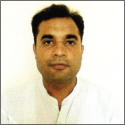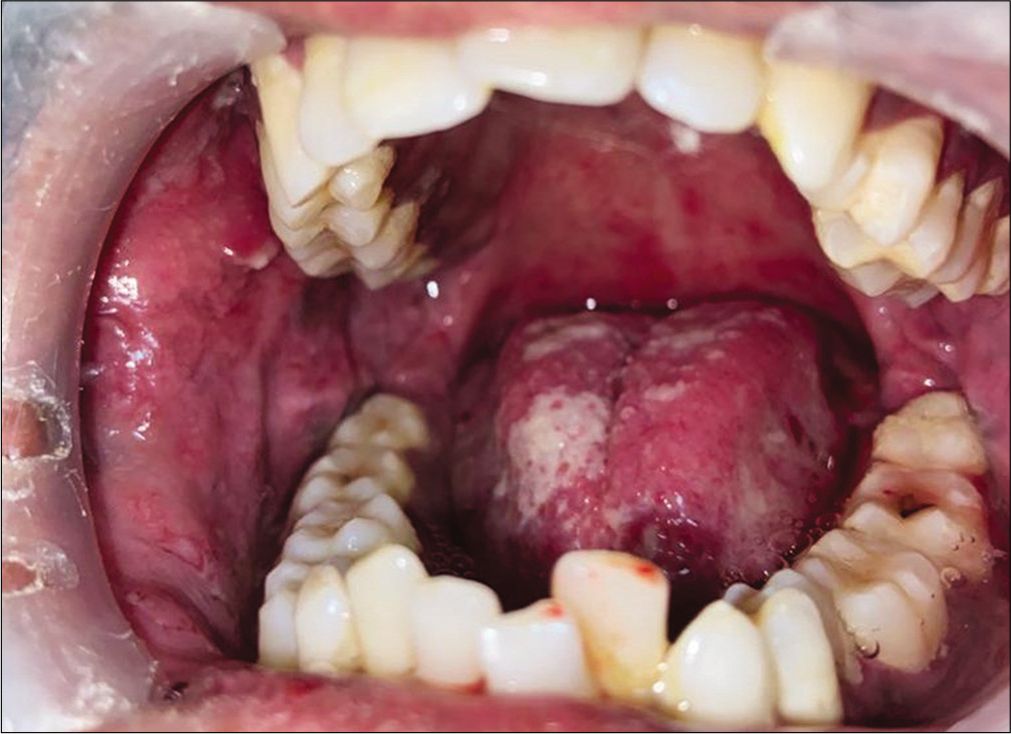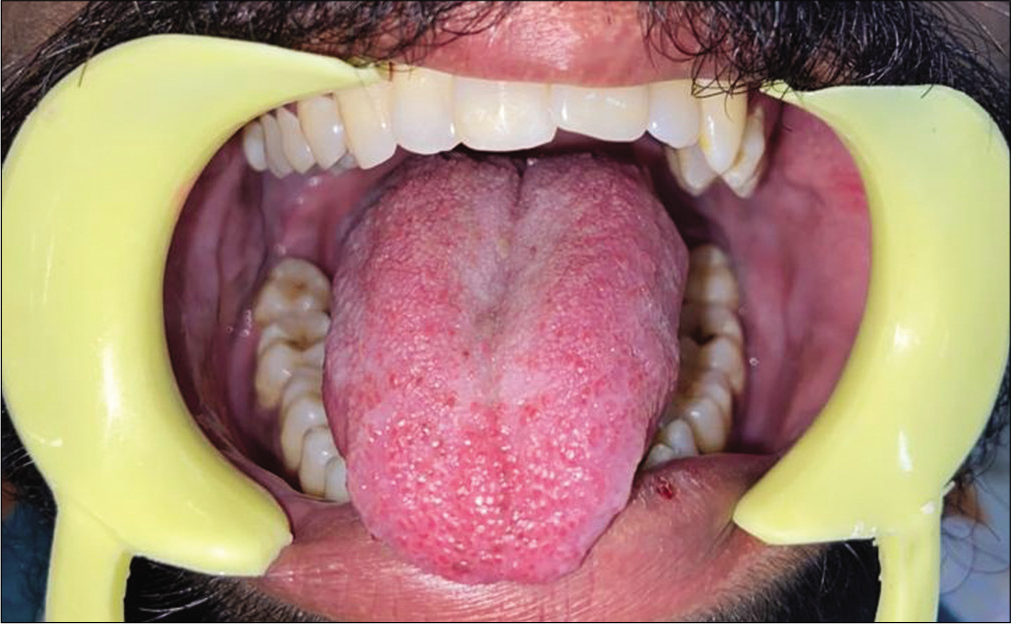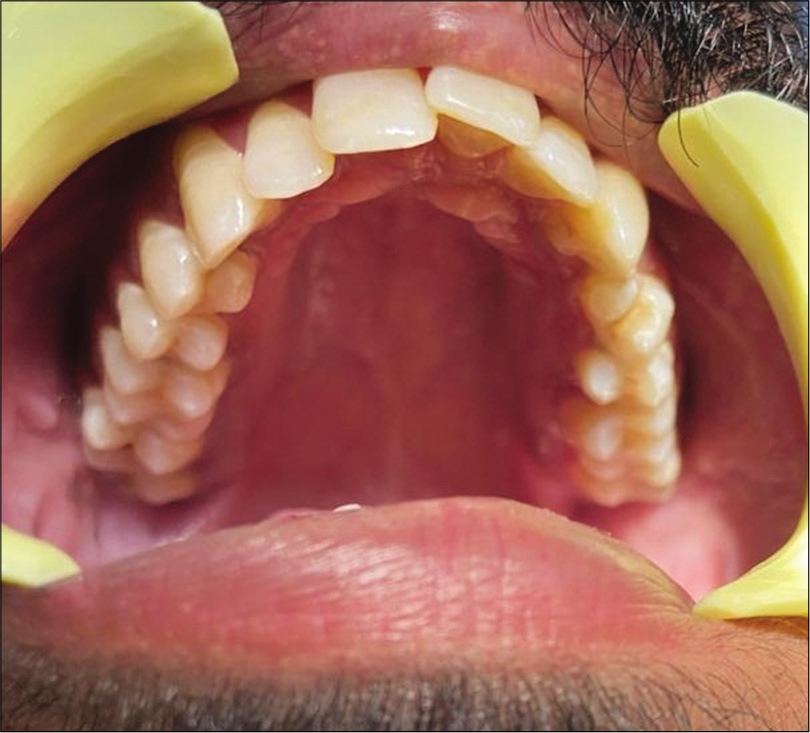Translate this page into:
Oral pemphigus vulgaris: A case report and review of the literature

*Corresponding author: Sudhir Rishi, 229 Green Avenue, Barnala, Punjab-148101, India. drsudhir09@gmail.com
-
Received: ,
Accepted: ,
How to cite this article: Rishi R, Chawla P, Dubey D. Oral pemphigus vulgaris: A case report and review of the literature. Adesh Univ J Med Sci Res 2022;4:42-5.
Abstract
The oral cavity presents with a variety of pathological lesions ranging from benign to malignant. Autoimmune mucocutaneous disorders of the oral cavity constitute an important group of lesions that pose diagnostic, therapeutic, and prognostic difficulties to the dental clinician. Many of the lesions may become potentially fatal if they are undiagnosed or misdiagnosed in their early stages. Pemphigus vulgaris is a potentially life-threatening autoimmune mucocutaneous disorder that causes blisters and erosions of the skin and the mucous membrane. It manifests clinically as vesicles, bullae, or desquamative gingivitis and histopathologically shows the presence of acantholysis. Eighty to ninety percent of patients with pemphigus vulgaris develop oral lesions and in 60% of cases, oral lesions are the first sign. Timely recognition and therapy of oral lesions are critical as they may prevent skin involvement. The incidence of pemphigus vulgaris occurs in a ratio of 2:1 (female: male). Adequate knowledge of diagnostic and therapeutic modalities helps the clinician in appropriate management. In this article, we report a case of oral pemphigus vulgaris in a 34-year-old male.
Keywords
Pemphigus vulgaris
Blisters
Autoimmune
Mucocutaneous
Oral lesions
Mucous membrane
INTRODUCTION
Pemphigus is a rare group of life-threatening vesiculobullous diseases characterized by cutaneous and mucosal blistering. Its global incidence rate was estimated around 0.2–3/100,000 persons/ year and expressed typically during the 5th and 6th decades of life with a male-to-female ratio of 1:2.2.[1,2] Pemphigus can be classified into six types: Pemphigus vulgaris, pemphigus vegetans, pemphigus erythematosus, pemphigus foliaceus, paraneoplastic pemphigus, and IgA pemphigus that cause erosions and blisters of the skin and mucous membranes. The most common variant of this condition is pemphigus vulgaris accounting for 80% of the cases.[1] The term “pemphix” is derived from the Greek root word “blister or pustule” and “vulgaris” from the Latin word “common” was originally named by Wichman in 1791.[1,2] It is characterized by the development of flaccid intraepithelial bullae that easily rupture creating areas of painful erosions and ulcerations. The oral cavity may present as the first site of involvement, so dentists must be able to recognize this condition and refer appropriately. Untreated generalized pemphigus vulgaris can be fatal; therefore, early diagnosis and treatment of oral lesions could ultimately improve the prognostic outcome. In many patients, pemphigus vulgaris manifests first in the oral cavity followed by skin lesions. While any area in the oral cavity can be involved, the soft palate, buccal mucosa, and lips are predominantly affected. Dental professionals must be sufficiently familiar with the clinical manifestations of pemphigus vulgaris to ensure early diagnosis and course of the disease. Most of the patients presented with pemphigus vulgaris are misdiagnosed in the early stages and being treated improperly for up to many months or years. Hence, as a general practitioner or dentist, it is essential to consider various lesions which mimic the pemphigus vulgaris in differential diagnosis and to carry out necessary investigations such as histopathological and immunofluorescence techniques.[3] This is a case report of a 34-year-old male presenting with oral pemphigus vulgaris.
CASE REPORT
A 34-year-old male patient reported to the Department of Oral Medicine with a history of painful ulcerations in the mouth since 6–7 months. History dates back to 7 months when the patient first noticed ulcerations in the mouth. History revealed that the ulcerations started initially as blisters and were associated with pain that was aggravated on chewing food. The ulcerations caused considerable discomfort, affecting his normal oral functions.
Personal and family histories were uneventful. The patient went to AIIMS Bathinda 2 months back with a chief complaint of recurrent oral ulcers and was diagnosed with Odynophagia and Candidiasis and was treated with Tab Fluconazole 150 mg 1 OD stat, Benzydamine mouthwash 3 times/day, Tab Benzoxonium Chloride (1 mg) + Lidocaine (1 mg) 3 times/day, Tab Rabeprazole + Domperodone 1 before breakfast, Multivitamin tablets 1 OD, Syrup Magaldrate (540 mg+ Simethicone (50 mg) + Oxetacaine (10 mg) 2 tsf 3 times/day, and Clotrimazole mouth paint (1% w/v) 3 times/day for 5 days, but there was no relief. After that, the patient went to some other hospital in Bathinda with the same chief complaint and was advised with a complete hemogram, viral markers human immunodeficiency virus, HBsAg, anti-hepatitis C virus, S. herpes simplex virus, liver function test, renal functional test, and venereal disease research laboratory test in serial direction to diagnose syphilis, Tzanck smear to detect any acantholytic cells, and multinucleate giant cells. Viral Markers were non-reactive; Herpes Simplex virus test was negative, rapid plasma reagin for syphilis was non-reactive. Tzanck Smear’s report shows multinucleated giant cells, along with squamous epithelial cells. No acantholytic cells were seen in the smear examined. After correlating clinically and investigations diagnosis of? Behcet’s disease with Candidiasis was made and treated with Tab Fluconazole 200 mg stat followed by 100 mg OD for 2 weeks, Clotrimazole mouth paint (1% w/v), Lignocaine viscous gargles 15 min before meals, Chlorhexidine gluconate (0.12%) mouth wash, and Choline Salicylate (8.7% w/w)+ Lidocaine (2% w/w) ointment. As there was no relief with the medications, so the patient was referred to Adesh Dental Hospital Bathinda. Careful history was taken and an examination was done. On intra-oral examination, multiple diffuse erythematous lesions with ulceration were found bilaterally on the buccal mucosa extending posteriorly to the retro molar trigone, right and left lateral borders of the tongue, posterior hard palate, and the soft palate extending to the oropharynx. On manipulation, bleeding was present. The white-colored curd-like patch was seen on the dorsal surface of the tongue which is scrapable [Figure 1]. A provisional diagnosis of acute vesiculobullous lesion of oral cavity and Candidiasis dorsum of tongue was made with differential diagnosis of recurrent aphthous ulceration, Behcet disease, erosive lichen planus, oral Candidiasis, and erythema multiforme, mucous membrane pemphigoid, bullous lichen planus, paraneoplastic pemphigus, chronic ulcerative stomatitis, recurrent herpes lesions in immune-compromised patients, and erythema multiforme.

- Intraoral photograph showing multiple diffuse erythematous lesions with ulcerations.
The patient was advised with a biopsy and direct immunofluorescence test. Routine hematological and biochemical investigations were done and were within normal limits.
Incisional biopsy from the representative site was performed under local anesthesia with due consent of the patient from the right buccal mucosa. Histopathological examination of both the specimen revealed non-keratinized stratified squamous epithelium showing areas of the suprabasal split. The basal cells showed histologic pattern as “row of tombstone.” The Cluster of Tzanck cells with hyperchromatic nuclei was seen lying freely in the vesicular space. The basal cells were attached to the basement membrane, along with underlying connective tissue. The underlying connective tissue revealed dense chronic inflammatory cell infiltration chiefly lymphocytes and plasma cells. The microscopic features were indicative of pemphigus vulgaris which was further confirmed by direct immunofluorescence test which revealed IgG in intercellular bridges in the epithelium. Based on clinical features, histopathological features, and immunofluorescence test, final diagnosis of oral pemphigus vulgaris was made.
The treatment was targeted to control the severity of the disease and prevent relapses. The treatment plan comprised Tab Prednisolone 1–2 mg/kg body weight which was prescribed 20 mg 4 times/day for 7 days, Tab Fluconazole 150 mg for 30 days in which 2 tabs on its day followed by 1 tab OD for 29 days, Topical Triamcinolone acetonide gel 3 times/day, Choline Salicylate (8.7% w/w) + Lidocaine (2% w/w) ointment 3 times/day, Multivitamin capsules 1 cap OD for 30 days, and Clotrimazole mouth paint (1% w/v) 3 times/day. On the first follow-up, the patient had reduction in symptoms. The dose of prednisolone was tapered to 20 mg 3 times/day for 7 days. On the second follow-up, there was much improvement in symptoms. The dose was tapered to 10 mg 4 times/day for 10 days. On the next follow, the patient was almost fine [Figures 2 and 3]. The patient was put on the maintenance dose of 5 mg 1 tab OD.

- On follow-up lesions were completely resolved.

- On follow-up, lesions were completely resolved.
DISCUSSION
Pemphigus is defined as a group of life-threatening, autoimmune blistering diseases of the skin, and mucous membrane. It is characterized by acantholysis (loss of keratinocyte cell adhesion) and bullous formation. The worldwide prevalence of pemphigus vulgaris is about 0.1–0.5%/million populations/year. The incidence of pemphigus, however, varies as per the geographic area and ethnic population.[4] The age of onset of disease is usually on the 5th and 6th decades of life with male-to-female ratio of 1:2.2. In 70–90% of the cases of pemphigus vulgaris, oral mucosa is involved before the involvement of the skin. The oral manifestations of pemphigus vulgaris typically run a chronic course causing blisters, erosions, and ulcers of the oral mucosa. The dermal manifestation is not a common occurrence, and many times, the oral lesions are the primary clinical presentation of pemphigus vulgaris. The common sites for oral mucosal lesions are gingiva, buccal mucosa, lips, and soft and hard palate. In the present case, erosive and ulcerative lesions were present on the buccal mucosa, retro molar area, lateral border of tongue, floor of mouth, and soft palate.[5]
Pemphigus vulgaris is the most common type contributing to more than 80% of the cases. It is a rare autoimmune disorder with intraepidermal bullous lesions which affect in specific oral, genital, or ocular mucosa and the epidermis, other mucous membrane is includes nasal mucosa, larynx, and esophagus. This disease is characterized by the loss of cellular adhesion due to the formation of IgG auto antibodies against desmoglein 1 or 3. This condition almost always affects the oral cavity, and it is the first sign of presentation in 70% of the cases before spreading to the skin and other mucosal surfaces. Clinically, the lesions manifest as thin-walled blisters anywhere in the mouth, especially at areas subjected to frictional trauma, for example, buccal mucosa, tongue, palate, and lower lips. These vesicles easily rupture leaving areas of denuded and hemorrhagic erosions.[1]
Literature data suggest that the prevalence of pemphigus vulgaris is lesser in India than the rest of the world and is in the range of 0.09% to 1.8%. Pemphigus vulgaris has a prolonged clinical course with significant morbidity and mortality. If pemphigus is left untreated, for 2 years, the mortality is 50% and at the end of 5 years, it is nearly 100%. The causes of mortality included extensive skin involvement, septicemia, bronchopneumonia, electrolyte imbalance, and secondary systemic infections.[4]
Vital to patient management is an early diagnosis, when lower doses rendered for shorter periods can effectively control the disease.[6] In general, pemphigus vulgaris is managed with topical and systemic steroids. Guidelines set by the British Association of Dermatologists recommended treatment of Pemphigus Vulgaris in two phases: Induction phase to control the disease and maintenance phase for consolidation and treatment tapering.[1,7] Depending on the response, the dose is gradually decreased to the minimum therapeutic dose, taken once daily to minimize side effects. The cornerstone of therapeutic approach is systemic and/or local corticosteroid therapy.[6]
Institution of the early treatment could prevent serious involvement of other mucosa and cutaneous sites and fatal complications.[8] Without appropriate management, pemphigus vulgaris could be fatal due to loss of the epidermal barrier, leading to dehydration and secondary bacterial infection.
Local treatment including ointments and mouthwashes can be used alone or in conjunction for managing the symptoms particularly in patients with low titer of circulating auto antibodies, for example, 0.1% triamcinolone acetonide in orabase, 0.05% clobetasol propionate, or 0.05% halobetasol. In refractory lesions, intralesional injection of triamcinolone acetonide (20 μg/L) or paramethasone can be administered every 7–15 days; however, if symptoms do not ameliorate, the treatment should be withdrawn.
In patients with extensive oral ulceration or cutaneous involvement, systemic corticosteroids are initiated immediately. Prednisolone dose of 0.5–1 mg/kg is recommended which is gradually reduced to the lowest therapeutic dose to minimize its side effects. Moreover, steroid sparing drugs such as cyclophosphamide and azathioprine are added to the regimen if long-term steroids are needed to control the complications of steroid therapy.[1]
Therefore, we need to induce and maintain remission with the lowest possible doses of medication to minimize the risk of serious and potentially fatal adverse effects. As a complement to local or systemic treatments, general dental practitioners could implement various treatments to enhance the patients’ well-being. This includes maintaining strict oral hygiene, periodontal treatment, dietary advice, close inspection of prosthetic restorations, and application of anti-Candida medications for patients on long-term steroids.
CONCLUSION
Dental professionals must be familiar with clinical manifestation of pemphigus vulgaris. If not treated promptly, the disease has a high morbidity rate in most of cases. An effective treatment plan should be chalked out to enhance patients’ quality of life, with a sole motto of accelerated remission, minimal hospitalization, and morbidity associated with therapeutic agents.
Declaration of patient consent
Patient’s consent not required as patients identity is not disclosed or compromised.
Financial support and sponsorship
Nil.
Conflicts of interest
There are no conflicts of interest.
References
- Oral pemphigus vulgaris: Dentists take-home message. Clin Case Rep. 2021;9:e04494.
- [CrossRef] [PubMed] [Google Scholar]
- Phemphigus vulgaris (PV) in male patient: A case report. JOJ Dermatol Cosmet. 2020;2:555587.
- [Google Scholar]
- Intraepithelial vesiculobullous lesions: Review and a case report. J Res Adv Dent. 2020;10:168-73.
- [Google Scholar]
- Pemphigus vulgaris: Case report and review of literature. J Clin Diagn Res. 2019;13:ZD04-6.
- [CrossRef] [Google Scholar]
- Oral Pemphigus vulgaris: A case report. J Chitwan Med Coll. 2020;10:91-3.
- [CrossRef] [Google Scholar]
- Pemphigus vulgaris a report of three cases and review of literature. J Family Med Prim Care. 2018;7:1109-12.
- [CrossRef] [PubMed] [Google Scholar]
- Oral mucosal changes in pemphigus vulgaris and its treatment: A case report. J Family Med Prim Care. 2019;8:4036-8.
- [CrossRef] [PubMed] [Google Scholar]
- Oral pemphigus vulgaris: Case report. Ethiop J Health Sci. 2015;25:367-72.
- [CrossRef] [Google Scholar]







